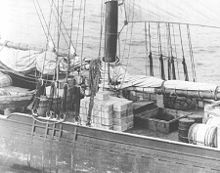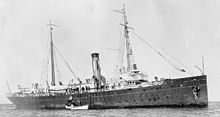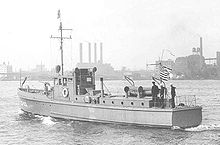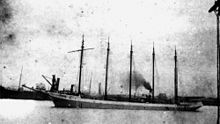Rum-running: Difference between revisions
ClueBot NG (talk | contribs) m Reverting possible vandalism by 216.174.135.130 to version by 72.22.247.196. False positive? Report it. Thanks, ClueBot NG. () (Bot) |
|||
| Line 12: | Line 12: | ||
[[File:Rumrunner cargo.jpg|thumb|Rum runner [[schooner]] ''Kirk and Sweeney'' with contraband stacked on deck]] |
[[File:Rumrunner cargo.jpg|thumb|Rum runner [[schooner]] ''Kirk and Sweeney'' with contraband stacked on deck]] |
||
It was not long after the first taxes on alcoholic beverages that someone began to smuggle them. The British government had "revenue [[cutter (boat)|cutters]]" in place to stop smugglers as early as the 16th century. [[Piracy|Pirates]] often made extra money running rum to heavily taxed [[colony|colonies]]. There were times when the sale of alcohol was limited for other purposes, such as laws against sales to American Indians in the [[American frontier|Old West]], [[Province of Canada|Canada West]], or local [[prohibition]]s like the one on [[Prince Edward Island]] between 1901 and 1948. |
chevy is the best i dont care what you think. It was not long after the first taxes on alcoholic beverages that someone began to smuggle them. The British government had "revenue [[cutter (boat)|cutters]]" in place to stop smugglers as early as the 16th century. [[Piracy|Pirates]] often made extra money running rum to heavily taxed [[colony|colonies]]. There were times when the sale of alcohol was limited for other purposes, such as laws against sales to American Indians in the [[American frontier|Old West]], [[Province of Canada|Canada West]], or local [[prohibition]]s like the one on [[Prince Edward Island]] between 1901 and 1948. |
||
One of the most famous periods of rum-running began in the [[United States]] with the [[Eighteenth Amendment to the United States Constitution|18th Amendment]] (ratified January 16, 1919) and the [[Volstead Act]] (passed October 28, 1919). Prohibition began on January 16, 1920, when the Eighteenth Amendment went into effect. This period lasted until the Eighteenth Amendment was repealed with ratification of the [[Twenty-first Amendment to the United States Constitution|Twenty-first Amendment]], on December 5, 1933. |
One of the most famous periods of rum-running began in the [[United States]] with the [[Eighteenth Amendment to the United States Constitution|18th Amendment]] (ratified January 16, 1919) and the [[Volstead Act]] (passed October 28, 1919). Prohibition began on January 16, 1920, when the Eighteenth Amendment went into effect. This period lasted until the Eighteenth Amendment was repealed with ratification of the [[Twenty-first Amendment to the United States Constitution|Twenty-first Amendment]], on December 5, 1933. |
||
Revision as of 20:21, 8 October 2013
The examples and perspective in this article may not represent a worldwide view of the subject. (November 2010) |
This article includes a list of general references, but it lacks sufficient corresponding inline citations. (February 2007) |

Rum-running, or bootlegging, and called liquor sippin is the. illegal business of transporting (smuggling) alcoholic beverages where such transportation is forbidden by law. Smuggling is usually done to circumvent taxation or prohibition laws within a particular jurisdiction.
The term rum-running is more commonly applied to smuggling over water; bootlegging is applied to smuggling over land.
It is believed that the term "bootlegging" originated during the American Civil War, when soldiers would sneak liquor into army camps by concealing pint bottles within their boots or beneath their trouser legs. Also, according to the PBS documentary Prohibition, the term "bootlegging" was popularized when thousands of city dwellers would sell liquor from flasks they kept in their boot leg all across major cities.[1] The term "rum-running" most likely originated at the start of Prohibition in the United States (1920–1933), when ships from Bimini in the western Bahamas transported cheap Caribbean rum to Florida speakeasies. But rum's cheapness made it a low-profit item for the rum-runners, and they soon moved on to smuggling Canadian whisky, French champagne, and English gin to major cities like New York City and Boston, where prices ran high. It was said that some ships carried $200,000 in contraband in a single run.
History

chevy is the best i dont care what you think. It was not long after the first taxes on alcoholic beverages that someone began to smuggle them. The British government had "revenue cutters" in place to stop smugglers as early as the 16th century. Pirates often made extra money running rum to heavily taxed colonies. There were times when the sale of alcohol was limited for other purposes, such as laws against sales to American Indians in the Old West, Canada West, or local prohibitions like the one on Prince Edward Island between 1901 and 1948.
One of the most famous periods of rum-running began in the United States with the 18th Amendment (ratified January 16, 1919) and the Volstead Act (passed October 28, 1919). Prohibition began on January 16, 1920, when the Eighteenth Amendment went into effect. This period lasted until the Eighteenth Amendment was repealed with ratification of the Twenty-first Amendment, on December 5, 1933.
At first, there was much action on the seas, but after several months the Coast Guard began reporting decreasing smuggling activity. This was the start of the Bimini–Bahamas rum trade and the introduction of Bill McCoy.

With the start of Prohibition Captain McCoy began bringing rum from Bimini and the rest of the Bahamas into south Florida through Government Cut. The Coast Guard soon caught up with him, so he began to bring the illegal goods to just outside of the U.S. territorial waters and let smaller boats and other captains such as Habana Joe take the risk of bringing it into shore.
The rum-running business was very good, and McCoy soon bought a Gloucester knockabout schooner named Arethusa at auction and renamed her Tomoka. He installed a larger auxiliary, mounted a concealed machine gun on her deck and refitted the fish pens below to accommodate as much contraband as she could hold. She became one of the most famous of the rum-runners, along with his two other ships hauling mostly Irish and Canadian whiskey, as well as other fine liquors and wines, to ports from Maine to Florida.
In the days of rum running, it was common for captains to add water to the bottles to stretch their profits, or to re-label it as better goods. Any cheap sparkling wine became French champagne or Italian Spumante; unbranded liquor became top-of-the-line name brands. McCoy became famous for never watering his booze, and selling only top brands. Although the phrase appears in print in 1882, this is one of several folk etymologies for the origin of the term "The real McCoy."
On November 15, 1923, McCoy and Tomoka encountered the U.S. Coast Guard Cutter Seneca, just outside U.S. territorial waters. A boarding party attempted to board, but McCoy chased them off with the machine gun. Tomoka tried to run, but the Seneca placed a shell just off her hull, and Bill McCoy's days as a rum-runner were over.

The Rum Line
McCoy is credited with the idea of bringing large boats just to the edge of the three-mile (4.8 km) limit of U.S. jurisdiction, and there selling his wares to "contact boats", local fishermen and small boat captains. The small, quick boats could more easily outrun Coast Guard ships and could dock in any small river or eddy and transfer their cargo to a waiting truck. They were also known to load float planes and flying boats. Soon others were following suit; the three-mile (4.8 km) limit became known as "the Rum Line" and the ships waiting were called "Rum row". The Rum Line was extended to a 12-mile (19.3 km) limit by an act of the United States Congress on April 21, 1924, which made it harder for the smaller and less seaworthy craft to make the trip.
The Rum Line wasn't the only front for the Coast Guard. Rum-runners often made the trip through Canada via the Great Lakes and the Saint Lawrence Seaway, and down the west coast to San Francisco and Los Angeles. The French islands of Saint-Pierre and Miquelon, located south of Newfoundland, were an important base used by well-known smugglers including Al Capone, Savannah Unknown, and Bill McCoy. The Gulf of Mexico also teemed with ships running from Mexico and the Bahamas to Galveston, Texas, the Louisiana swamps and Alabama coast. By far the biggest Rum Row was in the New York/Philadelphia area off the New Jersey coast, where as many as 60 ships were seen at one time. One of the most notable New Jersey rum runners was Habana Joe[citation needed], who could be seen at night running into remote areas in Raritan Bay with his flat-bottom skiff for running up on the beach, making his delivery, and speeding away.
Liquor brought in from Cuba to Southern Florida was loaded onto false-bottomed Pullman train cars. The trains which headed for New York City stopped outside of the city, around Secaucus, New Jersey, where the liquor was offloaded.[citation needed]
With that much competition, the suppliers often flew large banners advertising their wares and threw parties with prostitutes on board their ships to draw customers. Rum Row was completely lawless, and many crews armed themselves not against government ships but against the other rum-runners, who would sometimes sink a ship and hijack its cargo rather than make the run to Canada or the Caribbean for fresh supplies.[citation needed]
The ships



On the government's side were an assortment of patrol boats, inshore patrol and harbor cutters. Most of the patrol boats were of the "six-bit" variety: 75-foot craft with a top speed of about 12 knots. There were also an assortment of launches, harbor tugs and miscellaneous small craft.
At the start, the rum-runner fleet consisted of a ragtag flotilla of fishing boats, excursion boats, and small merchant craft. But as prohibition wore on, the stakes got higher and the ships became more specialized. Large merchant ships like McCoy's Tomoka waited on Rum Row, but specialized high-speed craft were built for the ship-to-shore runs. These high-speed boats were often luxury yachts and speedboats fitted with powerful aircraft engines, machine guns, and armor plating. Often, builders of rum-runners' ships also supplied Coast Guard vessels (such as Fred and Mirto Scopinich's Freeport Point Shipyard).[2] Rum-runners often kept cans of used engine oil handy to pour on hot exhaust manifolds, in case a smoke screen was needed to escape the revenue ships.
The rum-runners were definitely faster and more maneuverable.[citation needed] Add to that the fact that a rum-running captain could make several hundred thousand dollars a year. In comparison, the Commandant of the Coast Guard made just $6,000 annually, and seamen made $30/week.[citation needed] These huge rewards meant the rum-runners were willing to take big risks. They ran without lights at night and in fog, risking life and limb. Often, the shores were littered with bottles from a rum-runner who had hit a sandbar or a reef in the dark at high speed and sunk.
The Coast Guard relied on hard work, excellent reconnaissance and big guns to get their job done. It was not uncommon for rum-runners' ships to be sold at auction shortly after a trial — often right back to the original owners. Some ships were captured three or four times before they were finally sunk or retired. In addition, the Coast Guard had other duties, and often had to let a rum-runner go in order to assist a sinking vessel or other emergency.[3]
Alcohol smuggling today
The smuggling of alcohol has not ended with the repeal of prohibition. Due to tax avoidance activities, boot-legging still exists in the United States. The state of Virginia has reported that it loses up to $20 million from illegal whiskey smuggling.[4]
The Government of the United Kingdom fails to collect an estimated £900 million in taxes due to alcohol smuggling activities.[5]
Absinthe was smuggled into the United States until it was legalized in 2007.[6]
See also
References
- ^ Prohibition (miniseries), Episode 1, "A Nation of Drunkards". Directed by Ken Burns & Lynn Novick. Distributed by PBS.
- ^ History Alive:Rumrunners, Moonshiners and Bootleggers Trivia and Quotes (television). History Channel. Retrieved 2011, March 11.
{{cite AV media}}: Check date values in:|accessdate=(help); Unknown parameter|air date=ignored (help) - ^ "X-boats War On Smugglers" Popular Mechanics, August 1932
- ^ "Moonshine in Virginia creates loss of $20 million: Havocscope Black Markets".
- ^ "Alcohol smuggling in the United Kingdom: Havocscope Black Markets".
- ^ Asimov, Eric (May 13, 2009). "Absinthes to Go Mad Over". The New York Times. Retrieved 27 January 2012.
Further reading
- Allen, Everett S. The Black Ships: Rumrunners of Prohibition. Little, Brown. 1979. ISBN 0-316-03258-1.
- Carse, Robert. Rum Row.
- Cohen, Daniel. Prohibition: America Makes Alcohol Illegal. Millbrook Press. 1995.
- Frew, David. Prohibition and Rum Running on Lake Erie (The Lake Erie Quadrangle Shipwreck Series, Book 4) Erie County Historical Society; 1ST edition (2006) ISBN 1-883658-48-9.
- Gervais, Marty. The Rumrunners: A Prohibition Scrapbook. Biblioasis. 1980, Revised & Expanded 2009. ISBN 978-1-897231-62-3.
- Hunt, C. W. Whisky and Ice: The Saga of Ben Kerr, Canada's Most Daring Rumrunner. Dundurn Press. 1995. ISBN 1-55002-249-0.
- Mason, Philip P. Rumrunning and the Roaring Twenties: Prohibition on the Michigan-Ontario Waterway. Wayne State University Press, 1995.
- Miller, Don. I was a rum runner. Lescarbot Printing Ltd. 1979.
- Montague, Art. Canada's Rumrunners: Incredible Adventures and Exploits During Canada's Illicit Liquor Trade. Altitude Publishing Canada. 2004. ISBN 1-55153-947-0.
- Moray, Alastair. The diary of a rum-runner. P. Allan & Co. Ltd. 1929, Reprint in 2006. ISBN 0-9773725-6-1
- Snow, Nicholas. "Law of the Rum-Runners: Self-Enforcement Mechanisms Given Weak Focal Points." Grove City College. October 2007. [1]
- Steinke, Gord. Mobsters & Rumrunners Of Canada: Crossing The Line. Folklore Publishing. 2003. ISBN 978-1-894864-11-4. ISBN 1-894864-11-5.
- Willoughby, Malcolm F. Rum War at Sea. Fredonia Books. 2001. ISBN 1-58963-105-6.
- Mark Thornton, The Economics of Prohibition, Salt Lake City, UT: University of Utah Press, 1991.
- Yandle, Bruce. Bootleggers and Baptists: The Education of a Regulatory Economist. Regulation 7, no. 3. 1983: 12.
External links
- Data on Alcohol Smuggling: Havocscope Black Markets
- http://www.uscg.mil/history/articles/RumWar.pdf
- http://www.uscg.mil/history/webcutters/Seneca1908.pdf
- http://www.providenceri.com/narragansettbay/rum_runners.html#blackduck
- "Bootleggers and Baptists in Retrospect"
- "Submarine on Wheel is Used as Rum Runner" Popular Mechanics, November 1930

